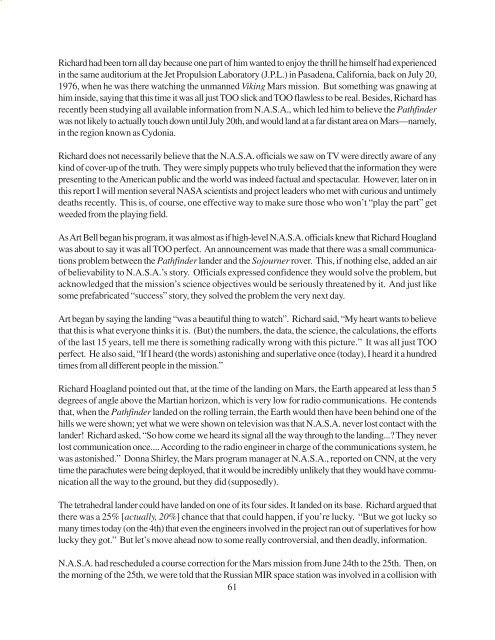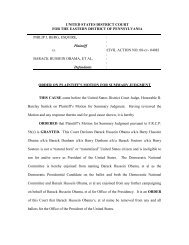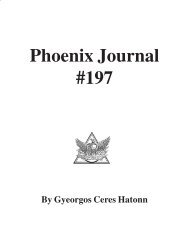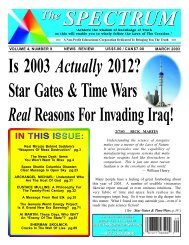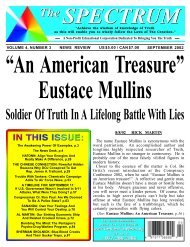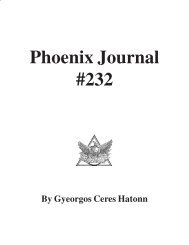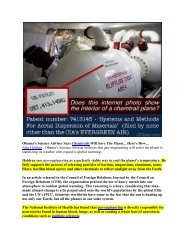Phoenix Journal 208 - Four Winds 10
Phoenix Journal 208 - Four Winds 10
Phoenix Journal 208 - Four Winds 10
Create successful ePaper yourself
Turn your PDF publications into a flip-book with our unique Google optimized e-Paper software.
Richard had been torn all day because one part of him wanted to enjoy the thrill he himself had experienced<br />
in the same auditorium at the Jet Propulsion Laboratory (J.P.L.) in Pasadena, California, back on July 20,<br />
1976, when he was there watching the unmanned Viking Mars mission. But something was gnawing at<br />
him inside, saying that this time it was all just TOO slick and TOO flawless to be real. Besides, Richard has<br />
recently been studying all available information from N.A.S.A., which led him to believe the Pathfinder<br />
was not likely to actually touch down until July 20th, and would land at a far distant area on Mars—namely,<br />
in the region known as Cydonia.<br />
Richard does not necessarily believe that the N.A.S.A. officials we saw on TV were directly aware of any<br />
kind of cover-up of the truth. They were simply puppets who truly believed that the information they were<br />
presenting to the American public and the world was indeed factual and spectacular. However, later on in<br />
this report I will mention several NASA scientists and project leaders who met with curious and untimely<br />
deaths recently. This is, of course, one effective way to make sure those who won’t “play the part” get<br />
weeded from the playing field.<br />
As Art Bell began his program, it was almost as if high-level N.A.S.A. officials knew that Richard Hoagland<br />
was about to say it was all TOO perfect. An announcement was made that there was a small communications<br />
problem between the Pathfinder lander and the Sojourner rover. This, if nothing else, added an air<br />
of believability to N.A.S.A.’s story. Officials expressed confidence they would solve the problem, but<br />
acknowledged that the mission’s science objectives would be seriously threatened by it. And just like<br />
some prefabricated “success” story, they solved the problem the very next day.<br />
Art began by saying the landing “was a beautiful thing to watch”. Richard said, “My heart wants to believe<br />
that this is what everyone thinks it is. (But) the numbers, the data, the science, the calculations, the efforts<br />
of the last 15 years, tell me there is something radically wrong with this picture.” It was all just TOO<br />
perfect. He also said, “If I heard (the words) astonishing and superlative once (today), I heard it a hundred<br />
times from all different people in the mission.”<br />
Richard Hoagland pointed out that, at the time of the landing on Mars, the Earth appeared at less than 5<br />
degrees of angle above the Martian horizon, which is very low for radio communications. He contends<br />
that, when the Pathfinder landed on the rolling terrain, the Earth would then have been behind one of the<br />
hills we were shown; yet what we were shown on television was that N.A.S.A. never lost contact with the<br />
lander! Richard asked, “So how come we heard its signal all the way through to the landing...? They never<br />
lost communication once.... According to the radio engineer in charge of the communications system, he<br />
was astonished.” Donna Shirley, the Mars program manager at N.A.S.A., reported on CNN, at the very<br />
time the parachutes were being deployed, that it would be incredibly unlikely that they would have communication<br />
all the way to the ground, but they did (supposedly).<br />
The tetrahedral lander could have landed on one of its four sides. It landed on its base. Richard argued that<br />
there was a 25% [actually, 20%] chance that that could happen, if you’re lucky. “But we got lucky so<br />
many times today (on the 4th) that even the engineers involved in the project ran out of superlatives for how<br />
lucky they got.” But let’s move ahead now to some really controversial, and then deadly, information.<br />
N.A.S.A. had rescheduled a course correction for the Mars mission from June 24th to the 25th. Then, on<br />
the morning of the 25th, we were told that the Russian MIR space station was involved in a collision with<br />
61


